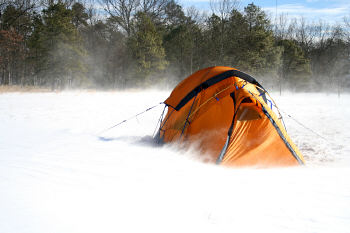How To Keep Your Tent Forever
by Kirby Kinkead
 A tent is your home away from home, your second skin. The right care will keep it reliable, and keep you protected, for years of many happy adventures. This article will give you the tips you’ll need to know to maintain your tent.
A tent is your home away from home, your second skin. The right care will keep it reliable, and keep you protected, for years of many happy adventures. This article will give you the tips you’ll need to know to maintain your tent.
First: Cleaning Your Tent
Usually you can just shake your tent, but occasionally it will need more thorough cleaning. Before you go off and try to clean your tent the way you clean other things, not bothering to read the rest of the instructions first (you know who you are), let me make one thing very, very clear: YOU SHOULD NEVER PUT YOUR TENT IN THE WASHING MACHINE OR DRYER!
Clear enough? Okay, to clean my tent, here is what I do.
Step One
I shake my tent (inside out) to get rid of large debris. Then I wipe the outside of the tent floor with a damp cloth to remove ground-in dirt, and vacuum the zippers with the brush attachment.
Step Two
I pitch my tent and clean the tent walls, inside and out, with Downe Suds (in any good sporting goods store). I sponge-rinse the tent TWICE to ensure all soap is gone. I never submerge it in water or rub waterproof coatings (like inside the tent floor and the underside of the rain fly).
Step Three
To remove sap from the tent, I scrape it with a non-serrated butter knife, being careful not to cut the fabric. DO NOT USE SOLVENT. For gooey sap I use tissue and carefully pinch off the sap (don’t rub or it will smear). A small spot is ok. Eventually it will collect dust and won’t be sticky. If I need to pack the tent right away, I stick tissue to the sap and remove it later. To remove the sap completely, I mix glycerin and water in equal parts and apply it to the sap, then let it sit. The sap should rub off the tent fabric easily. (If not, let it sit longer).
Step Four
A musty odor and/or small cross-shaped spots on tent fabric indicate mildew formation. To get rid of mildew I mix 1 cup salt, 1 cup lemon juice (concentrated), and 1 gallon of hot water. I rub the solution into all visible mildew. Then I pitch the tent with affected areas facing the sun and allow the tent to dry.
Second: Maintaining Your Tent
 Zipper sliders, the moving part of a zipper, wear from grit or sand, which causes failure over time. I use McNett’s Zip Care to lubricate my tent zipper to reduce wear. You can also use paraffin wax or bar of soap if you’re in a pinch. DO NOT USE PETROLEUM BASED LUBERICANTS.
Zipper sliders, the moving part of a zipper, wear from grit or sand, which causes failure over time. I use McNett’s Zip Care to lubricate my tent zipper to reduce wear. You can also use paraffin wax or bar of soap if you’re in a pinch. DO NOT USE PETROLEUM BASED LUBERICANTS.
If the sliders on my tent zippers start to fail, I squeeze the slider head (from front to back) firmly but gently with a pair of pliers.
Tent seams are not always waterproof. I seam seal them if I know I will be out in the heavy rain.
Third: Storing Your Tent Properly
I never put my tent away damp. Damp tents will mildew, smell, and eventually deteriorate. If you can’t pitch your tent outside to dry then use a guest room or a basement, just as long as the tent is dry before you pack it.
I pack my tent poles in old pillowcases or a canvas bag to prevent accidental punctures to tent fabric.
I pack my tent loosely. An oversized bag or cardboard box gives it breathing room. I don’t store my tent in a plastic bag or airtight container.
Proper care of your tent will make it last forever. I clean mine once a year after the camp season before long-term storage. Keep your tent clean. You’ll be glad you did.
Kirby Kinkead is a camper, backpacker, and outdoor enthusiast. Save on tents and other camping gear at his website or contact him by email: kirbykinkead at opentrees dot com.